Yesterday, Vera Wang's S/S17 show gave more than a subtle nod to the tradition of the gothic wedding. Here, we delineate its founding references, from Frankenstein to Yohji Yamamoto
When it comes to designing clothes, Vera Wang is nothing if not a woman’s woman. Her vision of femininity spans every nuance, from the fairytale ivory wedding gowns she has made her name creating since 1991, generous in fabric and princess-like in execution, to the graphic, sculptural silhouettes which first appeared in her groundbreaking all-black Autumn/Winter 2002 collection, and have recurred ever since. As a brand, Vera Wang is intrinsically female, combining fantastical reverie with a powerful simplicity – and the measure of each is balanced with a depth of understanding that can only come from somebody who is well-versed in both.

It makes sense, then, that when Wang stepped backstage after her Spring/Summer 2017 show yesterday – a collection which offset athletic utilitarianism with sensual volume – she described the prevailing themes to onlookers with one simple word. To quote her verbatim: “I’ll make it simple for you: black, black, black.” And black it was: off-the-shoulder sculptural jackets were worn over white wife-beater vests, extra-long voluminous sweater sleeves adding more than a hint of luxe sportswear to proceedings. Even so, a career's worth of experience creating bridal-wear crept out in the details; translucent floor-length open skirts trailed behind models like mesh veils; black lace A-line midi skirts creating an age-old peekaboo effect. Wang’s S/S17 collection was a knowing nod to a long tradition of gothic brides in fashion, but made a thoroughly contemporary impact.

Of course, wedding dresses were not always white: it wasn’t until Queen Victoria’s reign in the 19th century that the colour became fashionable at weddings, both as a symbol of a bride’s purity, and of her family’s wealth (white was notoriously difficult to keep clean). Conversely, in eastern cultures brides opt for red to bring gravity to the auspicious matrimonial moment, while traditional Swedish wedding dresses comprised a black gown with an ornate white collar and an elaborate headdress, and Spanish Roman Catholic brides, evidently taken with the sombre nature of the occasion, would wear black to symbolize their devotion "until death do us part". Nonetheless, pop culture designates black to gothic brides, calling on long-established tropes in horror films – see the 1935 classic The Bride of Frankenstein, in which a young Elsa Lanchester is seemingly swathed in paper for her marriage to the monster, or the femme fatale played by Nastassia Kinski in 1982 noir thriller Cat People, who seduces a lover into marrying her only to reveal her unnatural nocturnal pursuits.

The fashion industry has shown a similar fascination over the years, perhaps most notably brought to life by Yohji Yamamoto. In the 1990s, he staged not one but two shows riffing on weddings. S/S98 famously featured a hat so large it stretched the width of the catwalk, and had to be supported by four poles. S/S99’s Transformative Wedding collection marks the pinnacle of the obsession, however. In it, Yamamoto had bride-models undressing on the catwalk to reveal pencil gowns under their voluminous tulle skirts, and even featured the one and only André Leon Talley as a glorious groom. "Behind the wedding dress, there must be many stories," Yamamoto stated afterwards – a philosophy Wang surely shares.






